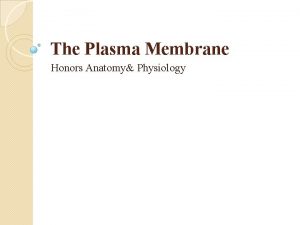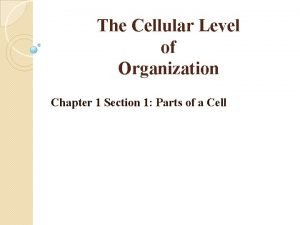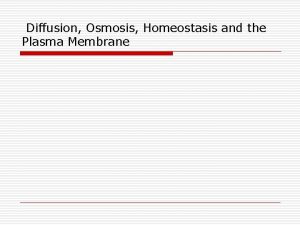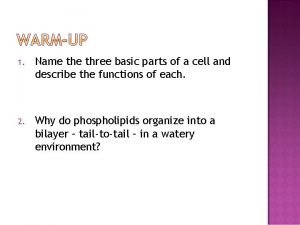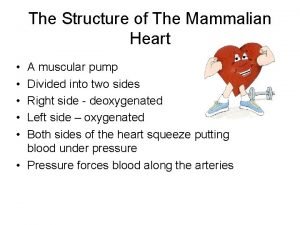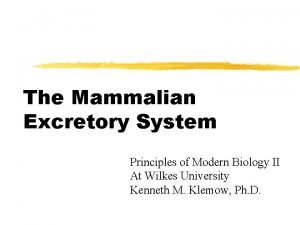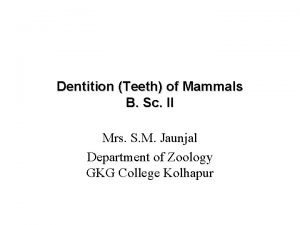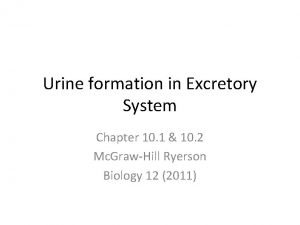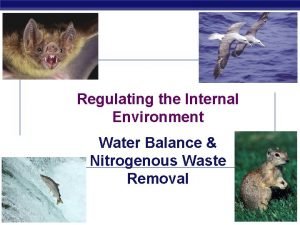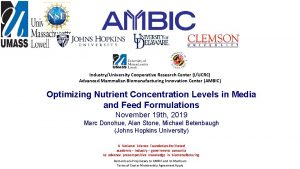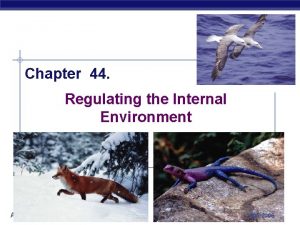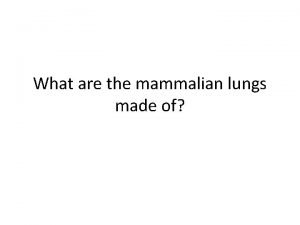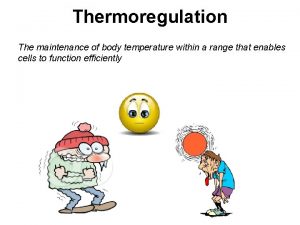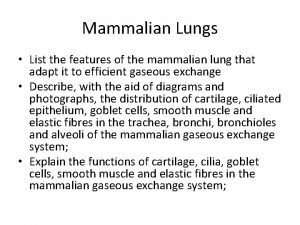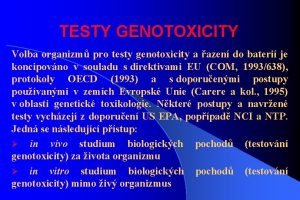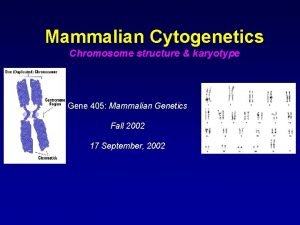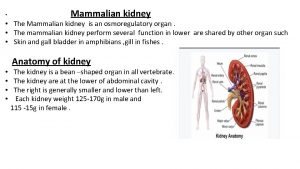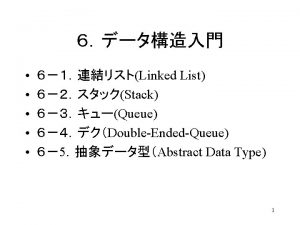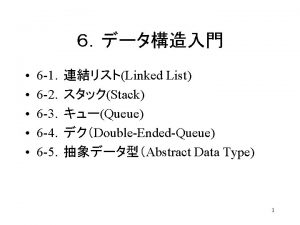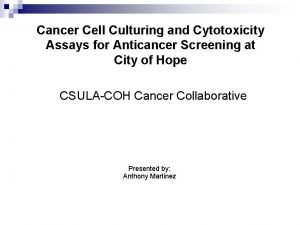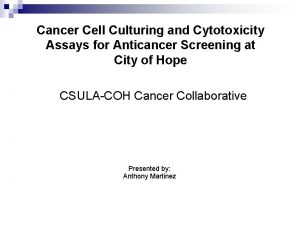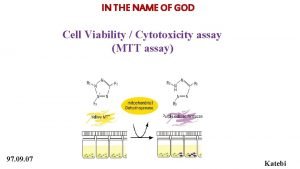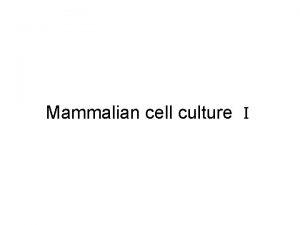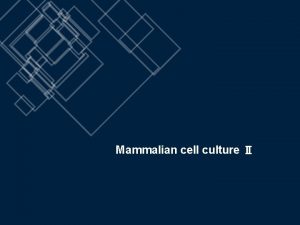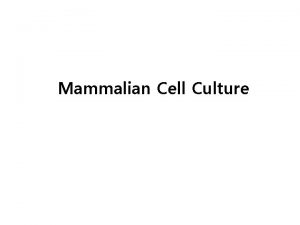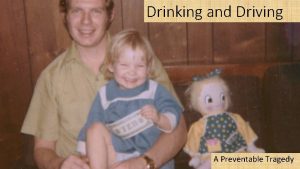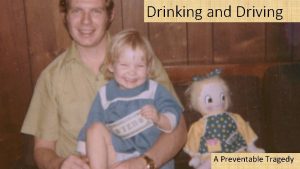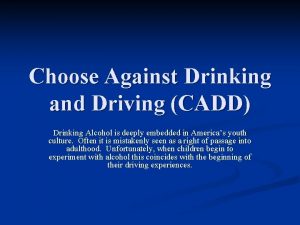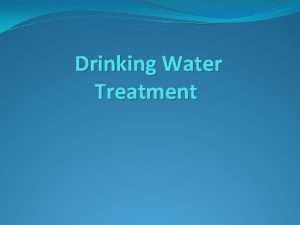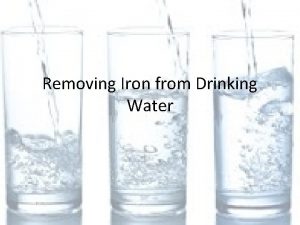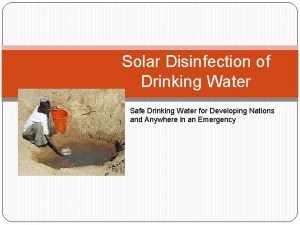Mammalian Cell Cytotoxicity and Genotoxicity of New Drinking














































- Slides: 46

Mammalian Cell Cytotoxicity and Genotoxicity of New Drinking Water Disinfection By-Products U. S. EPA Region 5 ORD STAR Seminar Dr. Michael J. Plewa Professor of Genetics University of Illinois at Urbana-Champaign EPA Region 5 July 2004 1

Water is the best of all things. Pindar (438 BC), Olympian Odes EPA Region 5 July 2004 2

EPA Region 5 July 2004 3

Safe Drinking Water: Benefits and Risks Drinking water disinfection was a major public health triumph of the 20 th century. The disinfectants greatly reduced the incidence of typhoid, cholera and other waterborne diseases. However, there is an unintended consequence of disinfection, the generation of chemical disinfection by-products (DBPs). EPA Region 5 July 2004 4

Drinking Water Disinfection By-Products (DBPs) • DBPs are compounds formed during drinking water disinfection as a result of the reaction between naturally occurring organic materials, synthetic organic contaminants and disinfectants. • Between 51% and 92% of DBP products are unknown in the halogenated organic fraction (TOX) depending on the disinfection process. EPA Region 5 July 2004 5

Regulation of DBPs • The health risks due to DBPs are not fully known, however, a substantial number of these agents were demonstrated to be toxic in many biological assays. In 1979 the EPA began the formal regulation of DBPs. • The regulation was extended in 1998 with the publication of the Stage 1 Disinfectants/Disinfection Byproducts Rule. • Stage 2 of the Rule is in the process of finalization. • Although over 600 DBPs have been isolated and identified, this represents only a fraction of the halogenated organic material that can be isolated after the disinfection of raw waters. EPA Region 5 July 2004 6

No DBP Toxicity Database • In 1999 the U. S. EPA, the National Institute of Environmental Health Sciences and the U. S. Army called for a comprehensive biological and mechanistic DBP database. • EPA employed a computer model-based structure-activity relationship (SAR) analysis of hundreds of DBPs. The SAR analysis was used to rank the carcinogenic potential of DBPs and identify a group of priority DBPs for further chemical and biological analysis. • The EPA also conducted a Nationwide DBP Occurrence Study. A list of priority DBPs was drawn up of approximately 50 agents that were not included in the Information Collection Rule and were estimated to be the most toxic. A second group of approximately 20 DBPs of similar chemical structure to the priority compounds was also defined. Also from the surveyed water treatment plants, 28 new DBPs were structurally identified. • There is virtually no toxicity data for most of these priority and new DBPs. EPA Region 5 July 2004 7

DBP Ignorance Summary distribution of DBP chemical classes in water analyzed in the U. S. EPA Nationwide Occurrence Study as a component of TOX. Data summarized by Dr. S. Krasner. EPA Region 5 July 2004 8

In a Recent Issue of the Journal Epidemiology • A panel of international experts stated, “These findings strengthen the hypothesis that the risk of bladder cancer is increased with long-term exposure to disinfection byproducts at levels currently observed in many industrialized countries. ” • Epidemiology 2004, 15: 357 -367 EPA Region 5 July 2004 9

Objectives of This Study • Analyze the cytotoxicity of the individual DBPs with Chinese hamster ovary (CHO) cells. • Determine the cytotoxic rank order of the DBPs. • Analyze the genotoxicity of the individual DBPs with CHO cells. • Determine the genotoxic rank order of the DBPs. • Employ these data in a U. S. Environmental Protection Agency risk assessment program. EPA Region 5 July 2004 10

Mammalian Cell Chronic Cytotoxicity Assay Chronic mammalian cell cytotoxicity is an important measure of the toxic impact of a test agent in which cells are continuously exposed throughout several cell divisions. Standard plating methods to measure toxicity are laborious, time consuming and require large amounts of sample. To address these problems we developed a rapid, semi-automated microplate-based, chronic cytotoxicity assay that measured the impact of a specific water DBP on cell survivorship. EPA Region 5 July 2004 11

Mammalian Cell Chronic Cytotoxicity Assay • CHO cells were exposed to a known concentration of a DBP in a microplate well for 72 h in a CO 2 incubator at 37°C. • After incubation the cells were fixed, stained with crystal violet, washed and 50 µl DMSO was added to each well and analyzed with a microplate reader at 595 nm. • The data were transferred onto an Excel spreadsheet and analyzed. • The absorbancy and the cell density were significantly and highly correlated (r = 0. 98, P < 0. 001). EPA Region 5 July 2004 (A) Absorption spectrum of crystal violet in the range from 340 to 800 nm. (B) A comparison of the number of cells per microplate well determined with a Coulter counter and the absorbancy of identical wells after crystal violet staining. 12

Determination of Optimal CHO Cell Plating Density 3000 CHO cells plated will grow to near confluency after 72 h. EPA Region 5 July 2004 13

CHO Cell Cytotoxicity of Dibromoacetic Acid: %C½ Value r 2 = 0. 99 The %C½ value is the concentration of each test agent that reduced the CHO cell density by 50% as compared to the negative control. The %C½ value is analogous to the LC 50 measurement. EPA Region 5 July 2004 14

EPA Region 5 July 2004 15

CHO Cell Cytotoxicity of Halonitromethanes EPA Region 5 July 2004 16

Comparison of DBP Chronic Cytotoxicity to CHO Cells The halonitromethanes were more cytotoxic to mammalian cells than the haloacetic acids. The brominated HNMs and HAAs were more cytotoxic than their chlorinated analogs. EPA Region 5 July 2004 17

DBP-Induced Mammalian Cell Cytotoxicity: Summary • Our microplate-based method allows for the analysis of a large number of concentrations per test agent and a large number of replicates per concentration. • Chronic mammalian cell cytotoxicity is an important toxicological measurement and is being used for risk assessment by the US EPA. • The cytotoxic potency (%C½ value) permits a quantitative comparison and rank ordering of the DBPs. • The HNMs were more cytotoxic than HAAs. • Brominated HNMs and HAAs were more cytotoxic than their chlorinated analogs. EPA Region 5 July 2004 18

Genomic DNA Damage Induced by Drinking Water Disinfection By-Products Single Cell Gel Electrophoresis The target is the genome, not just a gene. EPA Region 5 July 2004 19

DNA Damage EPA Region 5 July 2004 20

SCGE Analysis of 2 AAAF (in isolated nuclei from control and treated CHO cells) Negative Control EPA Region 5 July 2004 800 n. M 2 AAAF 21

Computer Analysis of SCGE Images • The nuclei were analyzed with a Zeiss fluorescence microscope using an excitation filter of BP 546/10 nm and a barrier filter of 590 nm. A computerized image analysis system was employed to measure various Comet parameters. • The tail moment is the integrated value of DNA density multiplied by the migration distance. EPA Region 5 July 2004 . 22

Acute Cytotoxicity • From each treated cell suspension a 10 µl aliquot was stained with 10 µl of 0. 05% trypan blue vital dye in PBS. • The percent survival for each treatment group was determined by counting the dead cells (blue) and the live cells (clear). EPA Region 5 July 2004 23

Genomic DNA Damage Induced by Dibromonitromethane Control 30 µM DBNM 40 µM DBNM EPA Region 5 July 2004 24

SCGE Analysis of Haloacetic Acids in CHO Cells EPA Region 5 July 2004 25

SCGE Analysis of Halonitromethanes in CHO Cells EPA Region 5 July 2004 26

DBP CHO Cell Genotoxicity In general, the halonitromethanes were more genotoxic to CHO cells than the haloacetic acids. The brominated HNMs and HAAs were more genotoxic than their chlorinated analogs. EPA Region 5 July 2004 27

Newly Identified Disinfection By-Products (2002 -2004) EPA Region 5 July 2004 28

Mass Spectra of 2, 3, 5 Tribromopyrrole and Iodoacetic Acid Tribromopyrrole Iodoacetic acid methyl ester EPA Region 5 July 2004 29

CHO Cell Chronic Cytotoxicity of Tribromopyrrole • In the chronic CHO cell cytotoxicity assay the level of cell killing by tribromopyrrole during the 72 h period was similar to that of BCNM and TBA. • The %C½ value was 60. 6 µM. EPA Region 5 July 2004 30

CHO Cell Chronic Cytotoxicity of Iodoacetic Acid • Iodoacetic acid was the most potent cytotoxic DBP among the 30 analyzed in our laboratory. • The %C½ value for iodoacetic acid was 2. 9 µM. EPA Region 5 July 2004 31

Rank Order of DBP CHO Cell Cytotoxicity The halonitromethanes were more cytotoxic to mammalian cells than the haloacetic acids. IA = 0. 003 TBP =0. 06 The brominated HNMs and HAAs were more cytotoxic than their chlorinated analogs. EPA Region 5 July 2004 32

Genotoxicity of Tribromopyrrole • Tribromopyrrole is a strong genotoxic agent in CHO cells. • The TM SCGE genotoxic potency of TBP is 301. 5 µM. EPA Region 5 July 2004 33

Genotoxicity of Iodoacetic Acid • Iodoacetic acid is the most potent genotoxic DBP (of 22) that we analyzed in CHO cells. • The TM SCGE genotoxic potency of iodoacetic acid is 7. 9 µM. EPA Region 5 July 2004 34

Rank Order of DBP CHO Cell Genotoxicity In general, the halonitromethanes were more genotoxic to CHO cells than the haloacetic acids. The brominated HNMs and HAAs were more genotoxic than their chlorinated analogs. EPA Region 5 July 2004 IA = 0. 008 TBP = 0. 301 35

Newly Identified Disinfection By-Products (2002 -2004) EPA Region 5 July 2004 36

Comparative Cytotoxicity of the Monohalogenated Acetic Acids • All of the monohalogenated acetic acids were chronic toxins to CHO cells. • The %C½ values for iodo-, bromo-, and chloro- acetic acid were 2. 9, 10. 0, and 848 µM, respectively. EPA Region 5 July 2004 37

Comparative Genotoxicity of the Monohalogenated Acetic Acids • All of the monohalogenated acetic acids were acute genotoxins to CHO cells. • The SCGE genotoxic potencies for iodo-, bromo- and chloroacetic acid were 7. 9, 17, and 411 µM, respectively. EPA Region 5 July 2004 38

DBP-Induced Mammalian Cell Genotoxicity: Summary • The mammalian cell microplate SCGE method allows for the quantitative genotoxic analysis of small amounts of test agent. • In general the HNMs are more genotoxic than HAAs. • The genotoxic potency for both the HNMs and HAAs is highest for the brominated analogs, followed by the bromo-chloro analogs, and then the chlorinated analogs. • New DBPs, such as tribromopyrrole and iodoacetic acid, can be rapidly analyzed for their cytotoxic and genotoxic activity in mammalian cells. EPA Region 5 July 2004 39

Mechanisms of Haloacetic Acid Genotoxicity • No DNA adducts have been identified. • Haloacetic acids (HAAs) induce mutation in Salmonella and mammalian cells. • HAAs are good inducers of DNA strand breaks in mammalian cells. • In rodent cancer studies HAAs caused peroxisome proliferation and may induce oxidative stress. EPA Region 5 July 2004 40

Effect of Catalase or BHA on Modulating Iodoacetic Acid Genotoxicity • Catalase is an enzyme that specifically degrades H 2 O 2. • Butylated hydroxyanisole is a potent radical scavenger. • We treated CHO cells with iodoacetic acid and catalase or BHA and determined SCGE DNA damage. EPA Region 5 July 2004 41

EPA Region 5 July 2004 42

Take-Home Message • Chemical disinfection of water reduced the incidence of waterborne diseases. • Disinfection unfortunately generates a large number of halogenated DBPs. • Epidemiological studies have linked consumption of water containing DBPs with enhanced risks of spontaneous abortion, birth defects and cancer. EPA Region 5 July 2004 43

Take-Home Message • The vast majority of DBPs that comprise TOX have not been chemically or biologically characterized. • The U. S. EPA has a high priority to identify DBPs and determine their toxicity. • We demonstrated that CHO cell microplate cytotoxicity and SCGE assays were sensitive and accurate when working with small amounts of DBPs. EPA Region 5 July 2004 44

Take-Home Message • The halonitromethanes (HNM) were both more cytotoxic and genotoxic as compared to the haloacetic acids. • The brominated and iodinated HAAs and HNMs were more cytotoxic and genotoxic than their chlorinated analogs. • HAAs induce their genotoxic damage via an oxidative stress mechanism. • The goal is to engineer drinking water disinfection technologies that generate the lowest levels of highly toxic DBPs. Our work is a step in this direction. EPA Region 5 July 2004 45

This research was funded in part by AWWARF grant 554, U. S. EPA grants R 825966, R 83069501, and NSF grant INT 97 -26617 EPA Region 5 July 2004 46
 Cell drinking
Cell drinking Cell drinking
Cell drinking Cell wall and membrane
Cell wall and membrane Cell drinking
Cell drinking Cell drinking
Cell drinking What is cell drinking
What is cell drinking Mammalian dive reflex
Mammalian dive reflex Mammalian heart
Mammalian heart Ekskresi
Ekskresi Dental formula of mammals
Dental formula of mammals Mammals characteristics
Mammals characteristics Mammalian excretory system
Mammalian excretory system Mammalian excretory system
Mammalian excretory system Mammalian biomanufacturing
Mammalian biomanufacturing Mammalian excretory system
Mammalian excretory system Structure of mammalian lungs
Structure of mammalian lungs Body temperature maintenance
Body temperature maintenance Mammalian lung diagram
Mammalian lung diagram Denuding tower
Denuding tower Linear chromosomes in eukaryotes
Linear chromosomes in eukaryotes Venn diagram plant vs animal cells
Venn diagram plant vs animal cells Plant cell and animal cell diagram
Plant cell and animal cell diagram Plant and animal cell diagram
Plant and animal cell diagram Primary voltaic cell
Primary voltaic cell Difference between bacteria and plant cell
Difference between bacteria and plant cell Section 10-2 cell division
Section 10-2 cell division Prokaryotic cell and eukaryotic cell
Prokaryotic cell and eukaryotic cell The scientist mathias schleiden studied _______ in ______.
The scientist mathias schleiden studied _______ in ______. Idealized plant cell
Idealized plant cell Walker cell and hadley cell
Walker cell and hadley cell Cell cycle and cell division
Cell cycle and cell division Animal cells and plant cells venn diagram
Animal cells and plant cells venn diagram Cell cycle and cell division
Cell cycle and cell division Electrolytic cell
Electrolytic cell Flexible covering of an animal cell
Flexible covering of an animal cell Drug psa ideas
Drug psa ideas Bmw drunk driving ad
Bmw drunk driving ad Drinking and driving solutions
Drinking and driving solutions Gerund of drink
Gerund of drink Chapter 6 drinking drugs and health
Chapter 6 drinking drugs and health Volvox diagram
Volvox diagram Site:slidetodoc.com
Site:slidetodoc.com S
S Dry cell vs wet cell
Dry cell vs wet cell Function of the cell wall
Function of the cell wall Cell wall cell membrane
Cell wall cell membrane Cell line vs cell strain
Cell line vs cell strain
